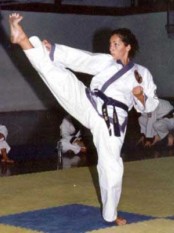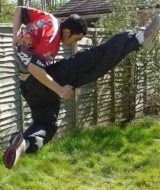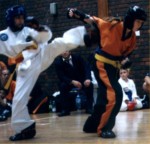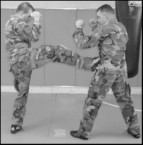One scenario: Front Kick = Any kind of front kick Front Snap Kick = A type of front kick Another scenario: Front kick refers to Front Snap Kick since it might be the only type of front kick used at that school. Types of front kicks as I know it. Many off shoots of TKD fostered different style instructors and different names which added to the confusion of terms. In the traditional TKD by Gen. Choi, front kick referred to just any front kick by context. If you were doing front snap kicks and the instructor says, "do the front kick again", you did the front snap kicks. Here are some front kicks I can think of right off the bat. They describe only type of front kicks. They are *not* in combination with side or round kicks. Not all kicks listed below are used in all TKD schools. Front rising/raising kick (no bending at the knees) Front snap kick (snaps at knee and comes back) x (ball of foot, tip of toes when wearing shoes) Front thrusting kick leaning back Front thrust kick leaning forward Front twisting kick to side (ball of the foot, snapping kick) Front thrusting kick to side (heel of the foot, pushing or snapping kick) Front kick (in-step of foot for kicking groin) Front twisting kick to face (ball of the foot angled straight upward, kicking knee is bent) Front axe (outside in) shaped like a "D" Front axe (inside out) shaped like a "reversed D" Front crescent (outside in) shaped like a "C with open end down" Front crescent (inside out) shaped like a "C with open end down" Front sweeping kick (starts as if kicking low front then hooks in or out to the side) Double front kick(in stationary position then you jump and both feet strike the target - this is found in Master Stuart Anslow's video, www.raynerslanetkd.com ) Front "flutter" kick. Continuous multiple alternating (left-right-left-right or right-left-right-left, etc) while on ground or in air. Good for points in tournaments. Add a hop to all of the above Add a "shuffle" to all of the above (used in tournament competition) Add jumping to all of the above Add low, medium, high to all of above Add retreat/step back to all of the above Add repeated same front kicks to all of the above (continuous without letting the foot touch the ground) Add repeated same front kicks to all of the above (continuous by touching the ground for "chambering") Add combinations of different front kicks (eg. front snap & axe kick, front snap) Do the above by doing the kicks with the front foot (i.e. lead foot) Do the above by doing the kicks with the rear foot (i.e. rear foot front kick) Do the above by advancing forward with one side only (i.e. left side) or by alternating sides. When training the above, I prefer practicing with bags ranging from 20lbs (focus) to 40 (both focus and power) to 100 lb (power). My training preference is kicking bags over the focus pads) since the kick to the bags (especially the 40 lb. ones) make a good simulation of a human target. Your preference may vary. I might also add that there are about 5 ways of doing basic front kicks. 1. Without power (for acceleration, feints, or focus) Training method: Do kicks with a stationary bag. The bag is barely touched. The purpose is focus. 2. With power thrusting (pushing effect) Training method: Swing the bag as far back as possible, and when it comes full speed at you, kick it so it gets "pushed" back. 3. Snapping kick (whipping effect) Swing the bag as far back as possible, and when it comes full speed at you, kick it so the chain "wails" upon impact, the bag goes back but "shudders" upon impact from your front kick. 4. "Jamming kick" a modification of #2 & #3. It stops just at the right point of impact as the bag comes in. Somewhere between a thrusting and a snapping front kick. Good timing is required. Training method: Swing the bag as far back as possible, and when it comes at full speed towards you, kick the bag so the bag stops "dead still" upon impact. 5. Accelerating, this comes by various movements. Leading with alternate foot by accelerating, rotating body (twirls), chambering with hips, leading with punches, combinations of several movements, etc. A slight upward rising movement (what some ITFers call sine wave when exaggerating this movement) also helps. Training method: This is for speed and can be done in many different ways (eg. two full body spins to deliver the kick, one full spin plus a one full counter spin before kick, to deliver the kick- running forward, leaning forward, continuous drills. etc). |
ARTICLES Whats the difference between a Front Kick & a Front Snap Kick by W. Rhee |




